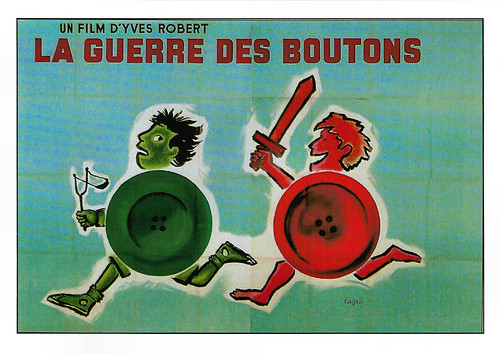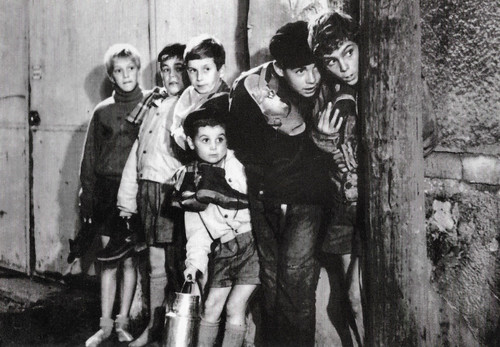Anita Ekberg (1931-2015) was a Swedish-born but naturalised Italian film actress. As Miss Sweden in 1950, she was contracted by Howard Hughes, had a Hollywood career in the 1950s, but got her real breakthrough in Italy. She made film history as the sensual, curvaceous film goddess who dances in the Trevi Fountain in Fellini’s La Dolce Vita (1960). She was also a sexy billboard figure coming to life in Fellini's short film La Tentazioni del Dottor Antonio/The Temptation of Doctor Antonio (1962).
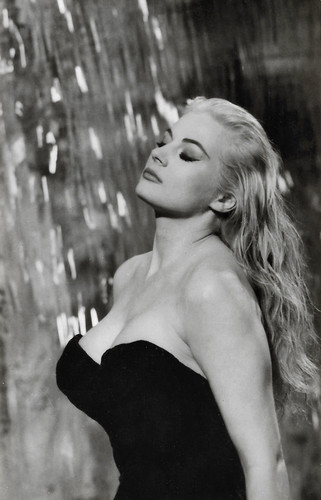
Romanian postcard by Casa Filmului Acin. Anita Ekberg in La Dolce Vita (Federico Fellini, 1960).
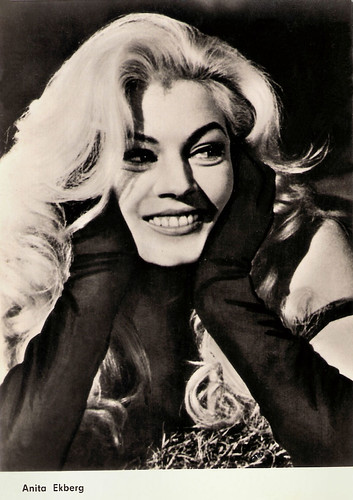
East-German postcard by VEB Progress Film-Vertrieb, Berlin, no. 2391, 1965. Anita Ekberg in Boccaccio '70 (Federico Fellini, 1962).
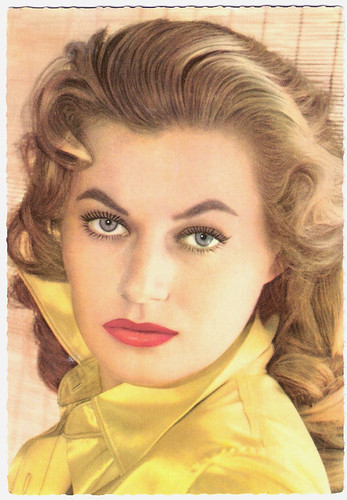
German postcard by ISV, no. F 10.

German postcard by ISV, no. D 8. Photo: Pierluigi.

Italian postcard by B.F.F. Edit., no. 3425. Photo: Paramount Films.
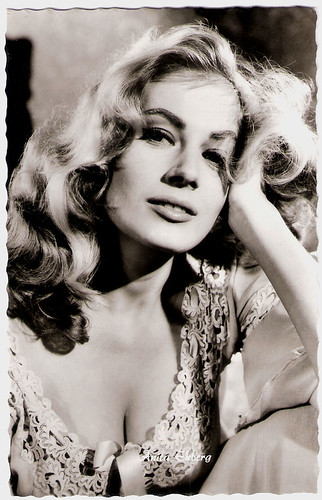
German postcard by Kolibri-Verlag, Minden/Westf., no. 150.
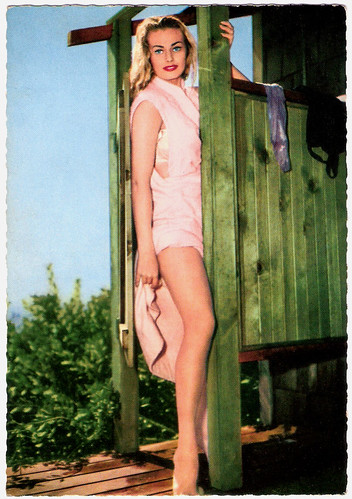
German postcard by ISV, Sort. VI/6.
Kerstin Anita Marianne Ekberg was born in Malmö, Sweden in 1931. She grew up with seven brothers and sisters. Having six brothers around surely developed a fierce independent spirit. In her teens, she worked as a fashion model, and in 1951 she was elected Miss Sweden. That year she also debuted in the film journal Terras fönster nr 5/Terra Journal No. 5 (Olle Ekelund, 1951), about the new beauty queen's visit to Stockholm. According to several sources, Ekberg went to the US for the Miss Universe contest, although she did not speak English. She didn't win but did get a modelling contract.
However, Marlene Pilaetein a La Collectionneuse post on the sadly discontinued website L'Encinématheque did extensive research regarding the Miss Universe contests and concluded that Ekberg was not in a Miss Universe contest: "The problem was that the first Miss Universe of the 'modern' era was crowned in June 1952, and Sweden's representative was a certain Anne Marie Tistler. We prefer to rely on Life magazine of 8 October 1951, which does indeed mention Anita Ekberg's presence on American soil, but as guest of honour at the 'Miss America' contest. It seems that this was the real reason for the young woman's arrival in the U.S. No mention was made of Miss Universe in this article.'In February 1952, Anita Ekberg won second place in the European Miss Casino beauty contest in Amsterdam. The winner was the English contestant, Judy Breen. Miss Nederland, Betty van Proosdij, came in third place.
Film mogul Howard Hughes gave her a contract with RKO and an American magazine compared her to another Hughes discovery: "Anita Ekberg: the girl who makes Jane Russell look like a boy". However, the contract didn't lead to films. Anita herself later claimed that Hughes wanted to marry her. Instead the voluptuous, husky-voiced blonde started making films for Universal. Her American debut was as a Venusian guard in Abbott and Costello Go to Mars (Charles Lamont, 1953). This was soon followed by The Golden Blade (Nathan Juran, 1953) starring Rock Hudson. These were small roles that only required her to look beautiful. She was nicknamed ‘The Iceberg’ - a play on her name and on her cool, quite mysterious demeanour.
While at Universal, Anita Ekberg quickly became one of Hollywood’s hot starlets thanks to her sexy photos, which were widely published in the press. She caught the hearts of many famous men including Tyrone Power, Errol Flynn, Frank Sinatra and Gary Cooper. Legendary director and photographer Russ Meyer called her 'the most beautiful woman he ever photographed'. He said her 40D bust line was 'the most ample in A list Hollywood history, dwarfing rivals like Jayne Mansfield'. Marlene Pilaete: "Now that silicone prostheses are commonplace, I think it's important to point out that it was Mother Nature alone who endowed Anita Ekberg with her good looks. But it would be unfair to reduce her to a pair of breasts. That would be to forget a face with regular features, a well-defined profile, a dazzling smile and an obvious photogenic talent."
Soon she became a major pin-up girl for the new type of men's magazine such as Playboy that proliferated in the 1950s. Ekberg also knew how to play the Hollywood tabloids and gossip columnists, creating stunts that she hoped would translate into film roles. Famously, she admitted that an incident where her dress burst open in the lobby of London's Berkeley Hotel was pre-arranged with a photographer. Her two marriages also gave her a lot of attention from the press. She married and divorced British actor Anthony Steel (1956-1959) and actor Rik Van Nutter (1963-1975). She reportedly had a three-year affair with the late Fiat chairman Gianni Agnelli. The press also loved her saucy quotes, like: "I'm very proud of my breasts, as every woman should be. It's not cellular obesity. It's womanliness."
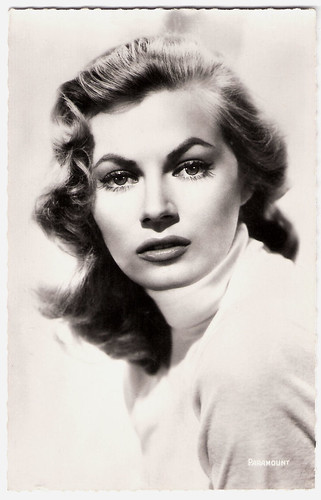
French postcard by Editions du Globe (EDUG), no. 521. Photo: Paramount.

French postcard by Editions P.I., Paris, no. 781. Photo: Paramount.
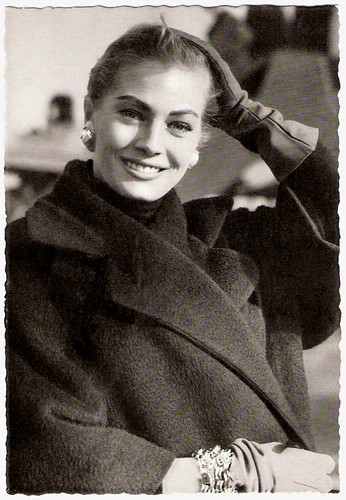
German postcard by WS-Druck, Wanne-Eickel, no. 203. Photo: dpa.
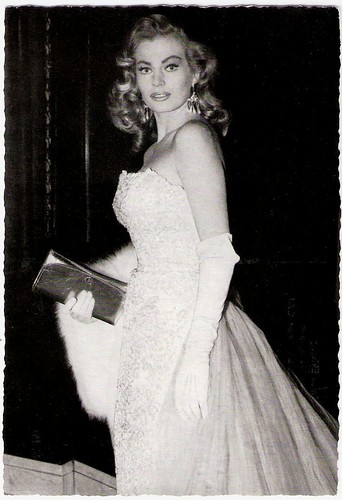
German postcard by WS-Druck, Wanne-Eickel, no. 181. Photo: dpa.
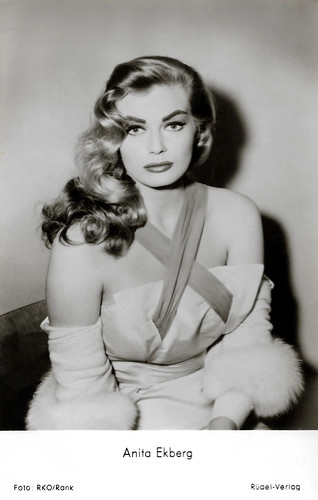
West German postcard by Rüdel-Verlag, Hamburg-Bergedorf, no. 3058. Photo: RKO / Rank. Anita Ekberg in Back from Eternity (John Farrow, 1956).
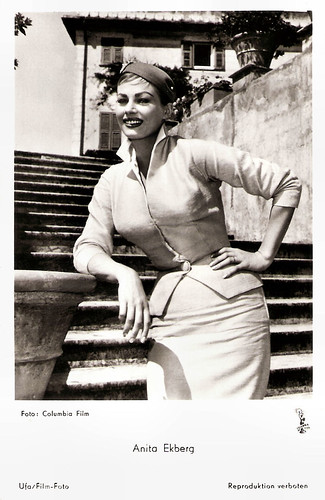
German postcard by Ufa, Berlin-Tempelhof, no. FK 3590. Photo: Columbia Film. Publicity still for Interpol (John Gilling, 1957).

Spanish postcard by Archivo Bermejo, no. 5922. Sent by mail in 1958. Anita Ekberg and Anthony Steel.
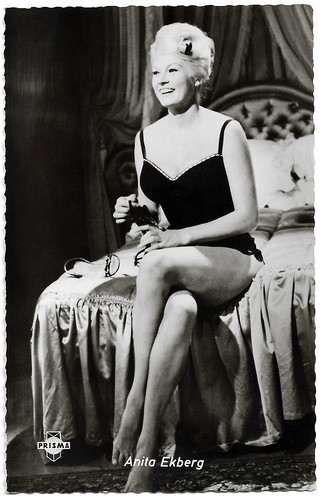
West German postcard by Kolibri-Verlag G.m.b.H., Minden/Westf., no. 1503. Photo: Prisma-Film. Anita Ekberg in Anonima cocottes/Little Girls and High Finance (Camillo Mastrocinque, 1960). The German title was Rosemarie G.M.B.H.
Anita Ekberg would get several offers from other studios. Bob Hope joked that her parents had received the Nobel Prize for architecture when he was touring with her and William Holden to entertain US troops in 1954. The tour led her to a contract with John Wayne's Batjac Productions. Wayne cast her in Blood Alley (William A. Wellman, 1955), a small role where Ekberg's features and appearance were Orientalised to play a Chinese woman. The role earned her a Golden Globe in February 1956 for the most promising newcomer of 1955, ex aequo with Victoria Shaw and Dana Wynter.
Her career as a star was now launched. Paramount Pictures cast her in the funny comedies Artists and Models (Frank Tashlin, 1955) and Hollywood or Bust (Frank Tashlin, 1956), starring Dean Martin and Jerry Lewis. These films showed off her stunning body and used her as a foil for many of the director's clever sight gags.
Ekberg went to Rome to make War and Peace (King Vidor, 1956) co-starring Audrey Hepburn. According to a newspaper of the time, the visit allowed her to cause a sensation with the Roman male sex. RKO gave Ekberg the female lead in Back from Eternity (John Farrow, 1956), co-starring with Robert Ryan and Rod Steiger. Ekberg was perfectly adequate in her cardboard role. With a good director and a worthwhile part, she might have something to offer.
In the British production Zarak (Terence Young, 1956) starring Victor Mature and Michael Wilding, her sexy harem-girl dance raised many eyebrows and blood pressure. With Bob Hope, she made two minor comedies, Paris Holiday (Gerd Oswald, 1958) and Call Me Bwana (Gordon Douglas, 1963).
One of her better films of this period was the Film Noir Screaming Mimi (Gerd Oswald, 1958). At IMDb, reviewer Lazarillo calls it "the missing link between American Film Noir and the Suspense and Horror films that would become so popular in continental Europe over the next two decades (i.e. the German 'Krimis', the Italian 'Gialli', the Horror films of Bava and Argento). It's technically a late-period Film Noir, but rather than having the traditional pessimistic tone and hard-boiled, voice-over narrative, it is completely off-the-wall and chock-full of the suggested depravity and lurid psycho-babble that would characterise the later European films. Interestingly, it was apparently based on the same Fredric Brown novel as Dario Argento's Bird with Crystal Plumage."
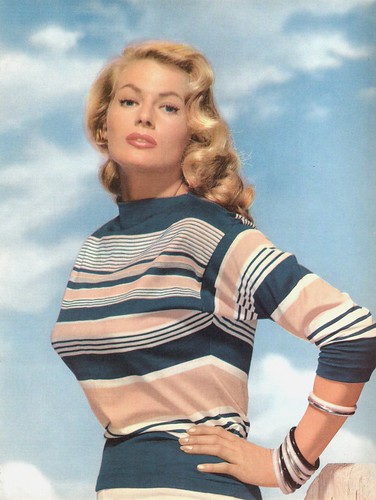
Vintage postcard.

French postcard, no. 101.
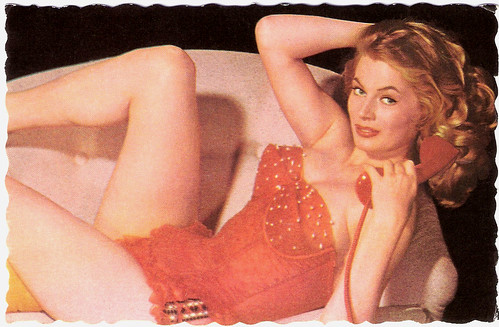
French postcard by De Marchi Frères, Marseille.

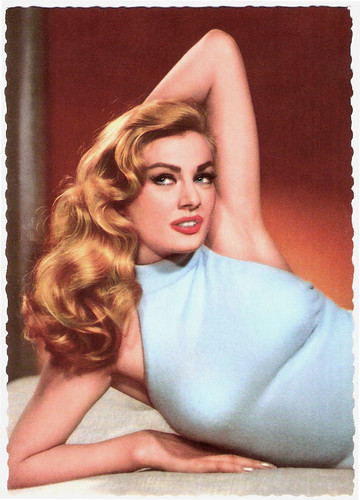
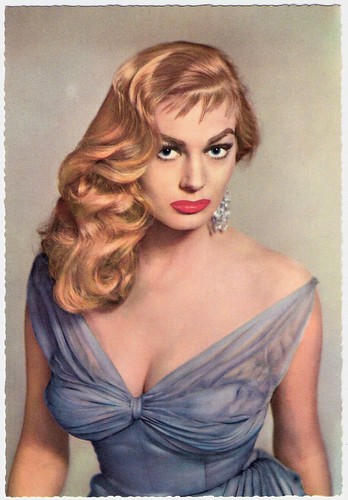
German postcard by ISV, no. H 23.

German postcard by WS-Druck, Wanne-Eickel. Photo: Klaus Collignon.
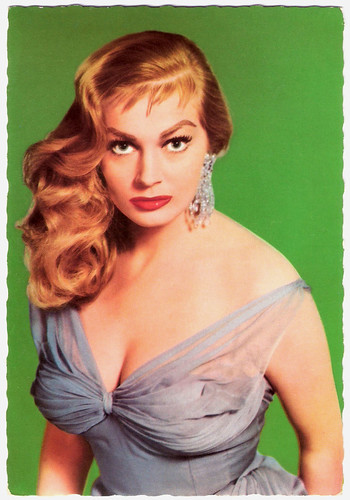
French postcard by EDUG, no. 151.
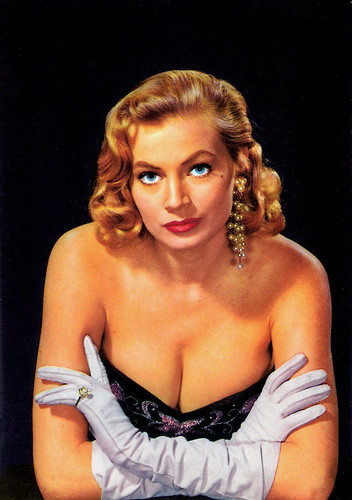
Italian postcard by Rotalcolor, Milano, no. N. 51.
In 1960 Anita Ekberg found herself again in Rome for her greatest role. She played the unattainable ‘dream woman’ Sylvia opposite Marcello Mastroianni in Federico Fellini's La Dolce Vita/The Sweet Life (1960). La Dolce Vita was a sensational success, and Ekberg's uninhibited cavorting in Rome's Trevi Fountain remains one of the most memorable screen images ever captured. Marlene Pilaete: "The actress and Italy were made for each other. It's funny to note that it was a Swede who perfectly embodied the madness of Roman nightlife in the 50s and 60s, much more so than the much wiser Sophia Loren, Gina Lollobrigida or Claudia Cardinale. It's precisely this slightly exaggerated side that appeals to me about Anita Ekberg."
Thus began a period when Ekberg would work almost exclusively in Europe. La Dolce Vita was followed by another memorable role for Fellini in his segment La Tentazioni del Dottor Antonio/The Temptation of Doctor Antonio of the anthology film Boccaccio '70 (1962). She plays a gigantic voluptuous lady on a billboard poster, promoting drinking milk and attracting huge crowds. At night she comes to live and pesters the little censor, played by Peppino De Filippo. Fellini would later call her back for two more films: I Pagliacci/I Clowns (Federico Fellini, 1971), and Intervista (Federico Fellini, 1987).
In 1964 she returned to Sweden to appear in Bo Widerberg's Kärlek 65/Love 65 (1965), but she cancelled her appearance and called the acclaimed director ‘an amateur’. In 1967 she co-starred with Shirley MacLaine in a segment of Vittorio de Sica’s Woman Times Seven (1967). For much of the 1960s though, she was trapped in substandard genre fare and lame comedies. During the 1970s the roles became less frequent. Fellini shot I Pagliacci/I Clowns for RAI. It was shown on television on Christmas Day 1970 before being released in cinemas. In 1982, at 50, she posed for glamour photos. Twenty-seven years after La Dolce Vita, she made a marvellous comeback with Fellini's film autobiography, Intervista (Federico Fellini, 1987), where she played herself in a reunion scene with Mastroianni and watched film clips of herself during her heydays. In 1995 Empire magazine chose her as one of the 100 Sexiest Stars in film history (#98).
While she remained active in films into the 1990s, the roles were hardly memorable. Exceptions came with her portrayal of an elderly restaurant owner who is killed in a gas explosion in Bámbola/Doll (Bigas Luna, 1996) featuring Valeria Marini, and her final role as an ageing, flamboyant opera who was strangled to death by a dwarf with whom she had had an affair in Le nain rouge/The Red Dwarf (Yvan Lemoine, 1998). Still blonde, but a bit heavier, Ekberg was able to project the requisite sensuality and diva-like behaviour resulting in a full-bodied performance that ranked among her best. Her last role in a TV series was in Il bello delle donne/The Beautiful One of the Women (2002) starring Stefania Sandrelli.
Since the early 1950s, Anita Ekberg never lived in Sweden and rarely visited the country. She welcomed Swedish journalists into her house outside Rome, and in 2005 appeared in the popular radio program 'Sommar', talking about her life. She stated in an interview that she would not move back to Sweden until she died when she would be buried there. In 2015, Anita Ekberg died at the clinic San Raffaele in Rocca di Papa, Italy. Her death was caused by complications from a long-time illness. She was 83. Marlene Pilaete: "I've been to Rome a few times and each time I pass the Trevi Fountain. Seeing the crowds of people gathered in front of this monument, I think to myself that the charities that benefit from the coins thrown away by tourists must thank Anita Ekberg and Fellini every day. They filmed one of the most legendary scenes of the Seventh Art and did a lot for the reputation of the place. Let's leave her with the final word, in an interview from 2011: 'I have no regrets. I loved it, I cried, I was crazy with happiness. I won and I lost...' That sounds just like her."

French postcard in the Collection Magie Noire by Editions Hazan, Paris, no. 6323. Anita Ekberg in La dolce vita (Federico Fellini, 1960).

Italian postcard by Bromofoto, Milano. Sent by mail in 1962. Photo: Dear Film.

Italian postcard, no. 445.

Italian postcard by Rotalfoto, Milano, no. 720.

German collectors card by Ufa/Film-Foto, Berlin, no. 27. Photo: Anita Ekberg in Le tre eccetera del colonnello/Three Etc.'s and the Colonel (Claude Boissol, 1960).

Romanian postcard by Casa Filmului Acin, no. 413. Anita Ekberg in I mongoli/The Mongols (André De Toth, Leopoldo Savona, Riccardo Freda, 1961).

Italian postcard by Rotalfoto, Milano, no. N. 170.

German postcard by Kolibri Verlag, Minden, no. 1960. Photo: Rank Film. Anita Ekberg in Call Me Bwana (Gordon Douglas, 1963).

East-German postcard by VEB Progress Film-vertrieb, Berlin, no. 3171, 1968. Retail price: 0,20 M. Photo: Pierluigi.
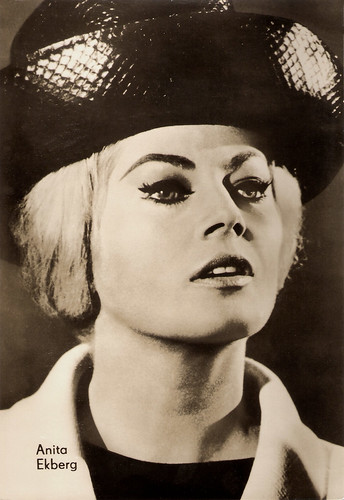
Big East-German card by VEB Progress Film-Vertrieb, Berlin, no. 262/69.

Spanish postcard by Postal Oscarcolor, no. 0902-65. Photo: Anita Ekberg in Woman Times Seven (Vittorio De Sica, 1967).

French postcard by Collection City Z. Paris, no. 20. Photo: Michel Giniès.
Trailer Artists and Models (1955). Source: Arnold Zieffel (YouTube).
Anita does a sexy dance in the thriller Screaming Mimi 1958). Source: Bachflat (YouTube).
Trailer Intervista (1987). Source: Buen Cine Dvd (YouTube).
Sources: Hal Erickson (AllMovie), Marlene Pilaete (L'Encinématheque - now defunct), Mattias Thuresson (IMDb), Java’s Bachelor Pad, TCM (page now defunct), Wikipedia, and IMDb.

Romanian postcard by Casa Filmului Acin. Anita Ekberg in La Dolce Vita (Federico Fellini, 1960).

East-German postcard by VEB Progress Film-Vertrieb, Berlin, no. 2391, 1965. Anita Ekberg in Boccaccio '70 (Federico Fellini, 1962).

German postcard by ISV, no. F 10.

German postcard by ISV, no. D 8. Photo: Pierluigi.

Italian postcard by B.F.F. Edit., no. 3425. Photo: Paramount Films.

German postcard by Kolibri-Verlag, Minden/Westf., no. 150.

German postcard by ISV, Sort. VI/6.
Miss Sweden
Kerstin Anita Marianne Ekberg was born in Malmö, Sweden in 1931. She grew up with seven brothers and sisters. Having six brothers around surely developed a fierce independent spirit. In her teens, she worked as a fashion model, and in 1951 she was elected Miss Sweden. That year she also debuted in the film journal Terras fönster nr 5/Terra Journal No. 5 (Olle Ekelund, 1951), about the new beauty queen's visit to Stockholm. According to several sources, Ekberg went to the US for the Miss Universe contest, although she did not speak English. She didn't win but did get a modelling contract.
However, Marlene Pilaetein a La Collectionneuse post on the sadly discontinued website L'Encinématheque did extensive research regarding the Miss Universe contests and concluded that Ekberg was not in a Miss Universe contest: "The problem was that the first Miss Universe of the 'modern' era was crowned in June 1952, and Sweden's representative was a certain Anne Marie Tistler. We prefer to rely on Life magazine of 8 October 1951, which does indeed mention Anita Ekberg's presence on American soil, but as guest of honour at the 'Miss America' contest. It seems that this was the real reason for the young woman's arrival in the U.S. No mention was made of Miss Universe in this article.'In February 1952, Anita Ekberg won second place in the European Miss Casino beauty contest in Amsterdam. The winner was the English contestant, Judy Breen. Miss Nederland, Betty van Proosdij, came in third place.
Film mogul Howard Hughes gave her a contract with RKO and an American magazine compared her to another Hughes discovery: "Anita Ekberg: the girl who makes Jane Russell look like a boy". However, the contract didn't lead to films. Anita herself later claimed that Hughes wanted to marry her. Instead the voluptuous, husky-voiced blonde started making films for Universal. Her American debut was as a Venusian guard in Abbott and Costello Go to Mars (Charles Lamont, 1953). This was soon followed by The Golden Blade (Nathan Juran, 1953) starring Rock Hudson. These were small roles that only required her to look beautiful. She was nicknamed ‘The Iceberg’ - a play on her name and on her cool, quite mysterious demeanour.
While at Universal, Anita Ekberg quickly became one of Hollywood’s hot starlets thanks to her sexy photos, which were widely published in the press. She caught the hearts of many famous men including Tyrone Power, Errol Flynn, Frank Sinatra and Gary Cooper. Legendary director and photographer Russ Meyer called her 'the most beautiful woman he ever photographed'. He said her 40D bust line was 'the most ample in A list Hollywood history, dwarfing rivals like Jayne Mansfield'. Marlene Pilaete: "Now that silicone prostheses are commonplace, I think it's important to point out that it was Mother Nature alone who endowed Anita Ekberg with her good looks. But it would be unfair to reduce her to a pair of breasts. That would be to forget a face with regular features, a well-defined profile, a dazzling smile and an obvious photogenic talent."
Soon she became a major pin-up girl for the new type of men's magazine such as Playboy that proliferated in the 1950s. Ekberg also knew how to play the Hollywood tabloids and gossip columnists, creating stunts that she hoped would translate into film roles. Famously, she admitted that an incident where her dress burst open in the lobby of London's Berkeley Hotel was pre-arranged with a photographer. Her two marriages also gave her a lot of attention from the press. She married and divorced British actor Anthony Steel (1956-1959) and actor Rik Van Nutter (1963-1975). She reportedly had a three-year affair with the late Fiat chairman Gianni Agnelli. The press also loved her saucy quotes, like: "I'm very proud of my breasts, as every woman should be. It's not cellular obesity. It's womanliness."

French postcard by Editions du Globe (EDUG), no. 521. Photo: Paramount.

French postcard by Editions P.I., Paris, no. 781. Photo: Paramount.

German postcard by WS-Druck, Wanne-Eickel, no. 203. Photo: dpa.

German postcard by WS-Druck, Wanne-Eickel, no. 181. Photo: dpa.

West German postcard by Rüdel-Verlag, Hamburg-Bergedorf, no. 3058. Photo: RKO / Rank. Anita Ekberg in Back from Eternity (John Farrow, 1956).

German postcard by Ufa, Berlin-Tempelhof, no. FK 3590. Photo: Columbia Film. Publicity still for Interpol (John Gilling, 1957).

Spanish postcard by Archivo Bermejo, no. 5922. Sent by mail in 1958. Anita Ekberg and Anthony Steel.

West German postcard by Kolibri-Verlag G.m.b.H., Minden/Westf., no. 1503. Photo: Prisma-Film. Anita Ekberg in Anonima cocottes/Little Girls and High Finance (Camillo Mastrocinque, 1960). The German title was Rosemarie G.M.B.H.
Foil for sight gags
Anita Ekberg would get several offers from other studios. Bob Hope joked that her parents had received the Nobel Prize for architecture when he was touring with her and William Holden to entertain US troops in 1954. The tour led her to a contract with John Wayne's Batjac Productions. Wayne cast her in Blood Alley (William A. Wellman, 1955), a small role where Ekberg's features and appearance were Orientalised to play a Chinese woman. The role earned her a Golden Globe in February 1956 for the most promising newcomer of 1955, ex aequo with Victoria Shaw and Dana Wynter.
Her career as a star was now launched. Paramount Pictures cast her in the funny comedies Artists and Models (Frank Tashlin, 1955) and Hollywood or Bust (Frank Tashlin, 1956), starring Dean Martin and Jerry Lewis. These films showed off her stunning body and used her as a foil for many of the director's clever sight gags.
Ekberg went to Rome to make War and Peace (King Vidor, 1956) co-starring Audrey Hepburn. According to a newspaper of the time, the visit allowed her to cause a sensation with the Roman male sex. RKO gave Ekberg the female lead in Back from Eternity (John Farrow, 1956), co-starring with Robert Ryan and Rod Steiger. Ekberg was perfectly adequate in her cardboard role. With a good director and a worthwhile part, she might have something to offer.
In the British production Zarak (Terence Young, 1956) starring Victor Mature and Michael Wilding, her sexy harem-girl dance raised many eyebrows and blood pressure. With Bob Hope, she made two minor comedies, Paris Holiday (Gerd Oswald, 1958) and Call Me Bwana (Gordon Douglas, 1963).
One of her better films of this period was the Film Noir Screaming Mimi (Gerd Oswald, 1958). At IMDb, reviewer Lazarillo calls it "the missing link between American Film Noir and the Suspense and Horror films that would become so popular in continental Europe over the next two decades (i.e. the German 'Krimis', the Italian 'Gialli', the Horror films of Bava and Argento). It's technically a late-period Film Noir, but rather than having the traditional pessimistic tone and hard-boiled, voice-over narrative, it is completely off-the-wall and chock-full of the suggested depravity and lurid psycho-babble that would characterise the later European films. Interestingly, it was apparently based on the same Fredric Brown novel as Dario Argento's Bird with Crystal Plumage."

Vintage postcard.

French postcard, no. 101.

French postcard by De Marchi Frères, Marseille.



German postcard by ISV, no. H 23.

German postcard by WS-Druck, Wanne-Eickel. Photo: Klaus Collignon.

French postcard by EDUG, no. 151.

Italian postcard by Rotalcolor, Milano, no. N. 51.
The sweet life
In 1960 Anita Ekberg found herself again in Rome for her greatest role. She played the unattainable ‘dream woman’ Sylvia opposite Marcello Mastroianni in Federico Fellini's La Dolce Vita/The Sweet Life (1960). La Dolce Vita was a sensational success, and Ekberg's uninhibited cavorting in Rome's Trevi Fountain remains one of the most memorable screen images ever captured. Marlene Pilaete: "The actress and Italy were made for each other. It's funny to note that it was a Swede who perfectly embodied the madness of Roman nightlife in the 50s and 60s, much more so than the much wiser Sophia Loren, Gina Lollobrigida or Claudia Cardinale. It's precisely this slightly exaggerated side that appeals to me about Anita Ekberg."
Thus began a period when Ekberg would work almost exclusively in Europe. La Dolce Vita was followed by another memorable role for Fellini in his segment La Tentazioni del Dottor Antonio/The Temptation of Doctor Antonio of the anthology film Boccaccio '70 (1962). She plays a gigantic voluptuous lady on a billboard poster, promoting drinking milk and attracting huge crowds. At night she comes to live and pesters the little censor, played by Peppino De Filippo. Fellini would later call her back for two more films: I Pagliacci/I Clowns (Federico Fellini, 1971), and Intervista (Federico Fellini, 1987).
In 1964 she returned to Sweden to appear in Bo Widerberg's Kärlek 65/Love 65 (1965), but she cancelled her appearance and called the acclaimed director ‘an amateur’. In 1967 she co-starred with Shirley MacLaine in a segment of Vittorio de Sica’s Woman Times Seven (1967). For much of the 1960s though, she was trapped in substandard genre fare and lame comedies. During the 1970s the roles became less frequent. Fellini shot I Pagliacci/I Clowns for RAI. It was shown on television on Christmas Day 1970 before being released in cinemas. In 1982, at 50, she posed for glamour photos. Twenty-seven years after La Dolce Vita, she made a marvellous comeback with Fellini's film autobiography, Intervista (Federico Fellini, 1987), where she played herself in a reunion scene with Mastroianni and watched film clips of herself during her heydays. In 1995 Empire magazine chose her as one of the 100 Sexiest Stars in film history (#98).
While she remained active in films into the 1990s, the roles were hardly memorable. Exceptions came with her portrayal of an elderly restaurant owner who is killed in a gas explosion in Bámbola/Doll (Bigas Luna, 1996) featuring Valeria Marini, and her final role as an ageing, flamboyant opera who was strangled to death by a dwarf with whom she had had an affair in Le nain rouge/The Red Dwarf (Yvan Lemoine, 1998). Still blonde, but a bit heavier, Ekberg was able to project the requisite sensuality and diva-like behaviour resulting in a full-bodied performance that ranked among her best. Her last role in a TV series was in Il bello delle donne/The Beautiful One of the Women (2002) starring Stefania Sandrelli.
Since the early 1950s, Anita Ekberg never lived in Sweden and rarely visited the country. She welcomed Swedish journalists into her house outside Rome, and in 2005 appeared in the popular radio program 'Sommar', talking about her life. She stated in an interview that she would not move back to Sweden until she died when she would be buried there. In 2015, Anita Ekberg died at the clinic San Raffaele in Rocca di Papa, Italy. Her death was caused by complications from a long-time illness. She was 83. Marlene Pilaete: "I've been to Rome a few times and each time I pass the Trevi Fountain. Seeing the crowds of people gathered in front of this monument, I think to myself that the charities that benefit from the coins thrown away by tourists must thank Anita Ekberg and Fellini every day. They filmed one of the most legendary scenes of the Seventh Art and did a lot for the reputation of the place. Let's leave her with the final word, in an interview from 2011: 'I have no regrets. I loved it, I cried, I was crazy with happiness. I won and I lost...' That sounds just like her."

French postcard in the Collection Magie Noire by Editions Hazan, Paris, no. 6323. Anita Ekberg in La dolce vita (Federico Fellini, 1960).

Italian postcard by Bromofoto, Milano. Sent by mail in 1962. Photo: Dear Film.

Italian postcard, no. 445.

Italian postcard by Rotalfoto, Milano, no. 720.

German collectors card by Ufa/Film-Foto, Berlin, no. 27. Photo: Anita Ekberg in Le tre eccetera del colonnello/Three Etc.'s and the Colonel (Claude Boissol, 1960).

Romanian postcard by Casa Filmului Acin, no. 413. Anita Ekberg in I mongoli/The Mongols (André De Toth, Leopoldo Savona, Riccardo Freda, 1961).

Italian postcard by Rotalfoto, Milano, no. N. 170.

German postcard by Kolibri Verlag, Minden, no. 1960. Photo: Rank Film. Anita Ekberg in Call Me Bwana (Gordon Douglas, 1963).

East-German postcard by VEB Progress Film-vertrieb, Berlin, no. 3171, 1968. Retail price: 0,20 M. Photo: Pierluigi.

Big East-German card by VEB Progress Film-Vertrieb, Berlin, no. 262/69.

Spanish postcard by Postal Oscarcolor, no. 0902-65. Photo: Anita Ekberg in Woman Times Seven (Vittorio De Sica, 1967).

French postcard by Collection City Z. Paris, no. 20. Photo: Michel Giniès.
Trailer Artists and Models (1955). Source: Arnold Zieffel (YouTube).
Anita does a sexy dance in the thriller Screaming Mimi 1958). Source: Bachflat (YouTube).
Trailer Intervista (1987). Source: Buen Cine Dvd (YouTube).
Sources: Hal Erickson (AllMovie), Marlene Pilaete (L'Encinématheque - now defunct), Mattias Thuresson (IMDb), Java’s Bachelor Pad, TCM (page now defunct), Wikipedia, and IMDb.


